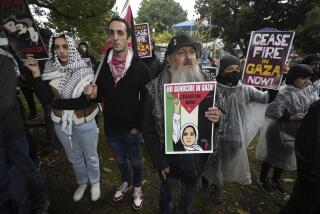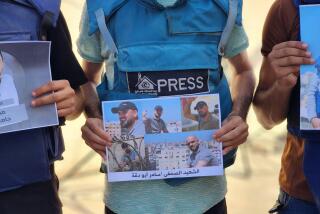An Israeli Report From a Palestinian Land
When Amira Hass, an Israeli journalist, moved to Gaza in 1993, her friends and colleagues thought she was crazy. Gaza is poor, filthy, crowded, and its inhabitants are regarded by many Israelis as anti-Semitic savages. Indeed, in Israel, “Go to Gaza” is a synonym for “Go to hell.”
A reporter for the Hebrew newspaper Ha’aretz, Hass was born in Jerusalem in 1957. Her interest in--and empathy for--the Palestinians grew from the experiences of her Eastern European parents, militant Communists and Holocaust survivors who raised their daughter on “epics of resistance.” Hass was particularly haunted by her mother’s memory of local German women watching with indifference as ravaged prisoners were herded to Bergen-Belsen: For Hass, “these women became a loathsome symbol of watching from the sidelines, and . . . I decided that my place was not with the bystanders.” Thus she yearned to see Gaza “through the eyes of its people, not through the windshield of an Army jeep.”
In this she was partly successful. Hass spent four years in Gaza, and she introduces us to a wide array of people, from an Islamic militant who ponders the usefulness of terror to a harried working mother in a refugee camp who studies Shakespeare “because life cannot be just food and children.” But the breadth of Hass’ reporting is in some ways a weakness: Hass never immerses us deeply in the lives of any of her characters, and her choppy book lacks a narrative arc. It reads, essentially, like a series of expanded newspaper articles.
Hass is most interesting when analyzing the sometimes surprising contradictions of Gazan society, which she sees as riven by schisms--”not only ideologically but also emotionally”--between leftists and fundamentalists, Fatah politicos and ordinary workers, refugees and natives, the desperately poor and the (newly) rich. She observes an inverse relationship between religious piety and political optimism: “[S]upport for the Islamic movement is closely tied to a sense of Palestinian impotence.” And she notes that while Yasser Arafat’s most militant speeches send shudders of fear throughout Israel, they make Gazans sigh with disappointment and cringe with shame, for Palestinians understand that “Arafat’s illusory use of language connotes strength where there is so little.”
Other paradoxes abound. While imprisonment during the intifada was obviously a horrible experience, it forced Palestinians and Israelis to interact on an individual, intimate, daily basis, thus shattering stereotypes and resulting in a “seismic shift” in perceptions. And then there is the oddity of Jews--historically so often the unarmed victims of military offensives--being equated with “uniforms, guns, death. . . . ‘If you’re a Jew,’ ” a 10-year-old Gazan boy asks Hass, “ ‘where’s your gun?’ ”
Hass’ tenure in Gaza coincided with the signing of the Oslo accords and the establishment of the Arafat-controlled Palestinian Authority, which Hass portrays as an unmitigated disaster. The authority, Hass reports, has created a bloated, violent police force, held fascistic secret trials, trained home-grown torturers and suppressed civil liberties. At the same time, she claims that Israel has used the accords to establish an extraordinarily repressive, apartheid-like pass system that controls the Palestinians’ freedom of movement (and therefore virtually every aspect of their lives). Hass downplays the role of continued terrorist bombings against Israel in creating, or at least perpetuating, this grim state of siege. But she is surely correct when she writes that, as the past has already shown, “the human distress of a million people is a sea of nitroglycerin.”
More to Read
Sign up for our Book Club newsletter
Get the latest news, events and more from the Los Angeles Times Book Club, and help us get L.A. reading and talking.
You may occasionally receive promotional content from the Los Angeles Times.








